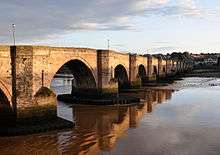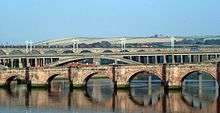Berwick Bridge
| Berwick Bridge | |
|---|---|
 | |
| Coordinates | 55°46′05″N 2°00′29″W / 55.768°N 2.008°WCoordinates: 55°46′05″N 2°00′29″W / 55.768°N 2.008°W |
| Crosses | River Tweed |
| Locale | Northumberland, England |
| Characteristics | |
| Material | Stone |
| Total length | 1,164 feet (355 m) |
| Width | 17 feet (5.2 m) |
| Number of spans | 15 |
| History | |
| Construction begin | 1608 |
| Opened | 1624 |
| Statistics | |
| Daily traffic | Single carriageway |
| Toll | No |
Berwick Bridge, also known as the Old Bridge, spans the River Tweed in Berwick-upon-Tweed, Northumberland, England. The current structure is a Grade I listed stone bridge built between 1611 and 1624.
History

Prior to the construction of the stone bridge, the crossing was served by a series of wooden bridges. which were variously destroyed by flooding and military action.[1][2] James Burrell became Surveyor of Works of the town in 1604, making him responsible for maintenance of the bridge.[3] He was previously also occupied on the fortifications around Berwick before James VI and I ascended the throne of England, rendering them redundant.[3]
In 1608, ten piers of the wooden bridge were destroyed by ice, and Burrell wrote to Robert Cecil, 1st Earl of Salisbury, then Secretary of State, to recommend the construction of a stone bridge.[3] Arrangements were made in May 1608 to collect funds, but only GB£3,300 had been collected by 1611, but the Captain of Berwick Sir William Bowyer was unsatisfied with this progress, and a proposal was made for a bridge with seven stone arches over the deepest part of the river and the rest built of wood.[3] After further collapse of the old wooden bridge, a modified proposal, for an entirely stone bridge with 13 arches, and estimated to cost a further GB£8,462, was put to the Privy Council, and on 16 May 1611 the King ordered GB£8,000 to be put towards the bridge.[3] Work started on the bridge on 19 June that year, and by September 170 men were employed on its construction.[3] At some point it was decided to build it with 15 arches instead.[3]
In 1618, a further GB£4,000 grant was given, but this money had been used by 1620 and the Privy Council placed the bridge project under the supervision of the Bishop of Durham Richard Neile before any more money was given.[3][4] Neile contracted Burrell and the leading mason Lancelot Bramston to finish the bridge at a cost of GB£1,750, and installed John Johnson of Newcastle as supervisor.[3] The bridge was complete by September 1621 except for the parapets and paving, but a flood in October 1621 swept away some masonry and the wooden centring.[3] In light of the accident, a grant of GB£3,000 was made and work restarted the following March, and the bridge was opened to traffic in 1624, although minor work continued for the next decade.[3][4][5]
The bridge became less important for road traffic as the main route moved westwards, first to the concrete Royal Tweed Bridge built in the 1920s, and then in the 1980s a bypass took the A1 road out of Berwick altogether.[6]
It is a Grade I listed building and a scheduled monument.[7][8]
Design
.jpg)
The bridge is 1,164 feet (355 m) long and 17 feet (5.2 m) wide between the parapets, with an upwards slope towards the north-eastern end.[5] The spans are not even in length, and range between 24 feet (7.3 m) and 75 feet (23 m), the longest being the penultimate span at the north-eastern end.[3][5]
It is built from sandstone quarried at Tweedmouth.[5] The piers are founded on large oak piles from 873 trees, mainly taken from Chopwell Forest.[3]
The triangular cutwaters extend up to the level of the deck to become pedestrian refuges.[3]
The bridge is now one way, from east to west. A short distance upstream is the Royal Tweed Bridge, which succeeded the Berwick Bridge as the main road crossing of the Tweed at Berwick when it opened in 1928.[9] In 1984, the A1 River Tweed Bridge opened about a mile to the west of Berwick, carrying the A1 road around the town.[6] The railway through Berwick is carried on the Royal Border Bridge, slightly further upstream from the two road bridges.[9]
References
- ↑ "Berwick Bridge". scotlandsoldestbridges.co.uk. Retrieved 7 August 2015.
- ↑ Berwick-upon-Tweed: Three places, two nations, one town (PDF). English Heritage. 2009. pp. 23–26. ISBN 9781848020290.
- 1 2 3 4 5 6 7 8 9 10 11 12 13 14 Skempton, A. W. (2002). A Biographical Dictionary of Civil Engineers in Great Britain and Ireland: 1500-1830. Thomas Telford. pp. 108–109. ISBN 978-0-7277-2939-2.
- 1 2 "Berwick-upon-Tweed". historyofparliamentonline.org. Retrieved 8 August 2015.
- 1 2 3 4 "Berwick Bridge". sine.ncl.ac.uk. Archived from the original on July 17, 2012. Retrieved 8 August 2015.
- 1 2 "Berwick A1 Bridge". bridgesonthetyne.co.uk. Retrieved 5 August 2015.
- ↑ "Berwick Bridge". historicengland.org.uk. Retrieved 7 August 2015.
- ↑ "Berwick Bridge". engineering-timelines.com. Retrieved 7 August 2015.
- 1 2 Google (5 August 2015). "Berwick Bridge" (Map). Google Maps. Google. Retrieved 5 August 2015.
External links
| Wikimedia Commons has media related to Berwick Bridge. |